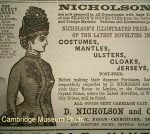Collections
Our Cambridge Collection has changing exhibitions about Cambridge. Much of our collection is in storage to ensure its preservation for future generations.
Advertising

Anyone who has the opportunity to browse through old newspapers and magazines will know what fun it is to read the advertisements.
Delving into history reveals that outdoor signs were the first forms of advertising when merchants hung symbols of their goods outside their shops.
In ancient Egypt criers were hired to announce the arrival of ships and their cargo. These were the forerunners of the town criers of the 10th century that were common in Britain and Europe.
Their “hear ye, hear ye” sang out the latest news and announced town meetings and other events.
The first printed English advertisement was in 1472 when William Caxton printed a poster and tacked it onto church doors announcing the sale of a book.
In the 17th century the newspaper the ‘Weekly News’ was printed in England and by this time advertising was in full swing.
The sandwich man was a popular form of advertising in the 19th century when men were hired to carry placards up and down the streets (sometimes on horse back) promoting goods and services to the public.
The early New Zealand newspapers announced the arrival and departures of ships. Then the shopkeepers would advertise their new shipments.
This advert, in the Nelson Examiner 1863, was spotted by a keen genealogist.
“Three young men of tolerably presentable appearance are looking for wives not utterly repulsive in appearance, and over 5’5″ in her stockings. NB An accompaniment of £500 with any applicant, or an equivalent in wire fencing, would be deemed there (sic) verse of an encumbrance.”
In 1895 J S Bond started a weekly paper in Cambridge, the Waikato Advocate, but in the same year he moved his plant to Hamilton and incorporated his paper with the Waikato Times.
Advertising in the Waikato Advocate included whole booklists published from Wildman and Lyell – 2/6d paperbacks and 3/6d cloth bound; Upton and Co advertised £5 for a library of 50 well selected standard works, sent carriage paid; Belle Sauvage library offered clear type, good paper and bound in blue cloth with gilt lettered title 2/6d each.
In 1904 David Pirani established the Waikato Independent as a tri-weekly. In 1905 advertisements appeared as follows:-
Robert Tudehope’s announcement that he’s off to marry Millie Pepper at Carterton.
W Clifford has found business booming and has had to expand.
E B Hill treats horses as well as people in his chemist shop – where Munro Burgess’s premises are now.
Edward Boucher Hill also took and developed photos to give away to prompt-paying customers, and his darkroom was available to residents and visitors, free of charge.
Advertising is here to stay, it is a way of life and has become part of our lives whether we like it or not. We get bombarded from the TV, radio, newspapers, magazines, on the streets, through our letterboxes, emails, phones and social media. Advertising agents even advertise the most profitable way to advertise.
I wonder if in a hundred years time people will look back and find our advertising as quaint as that of 100 years ago.
Researched and written by Eris Parker
Ref: Cambridge Museum Archives
